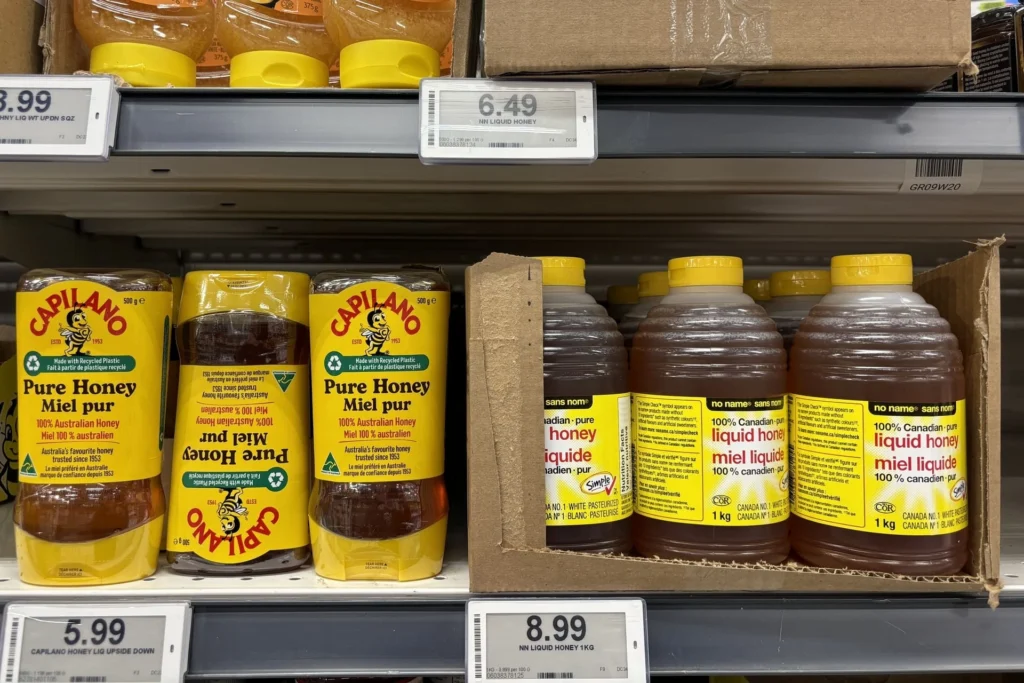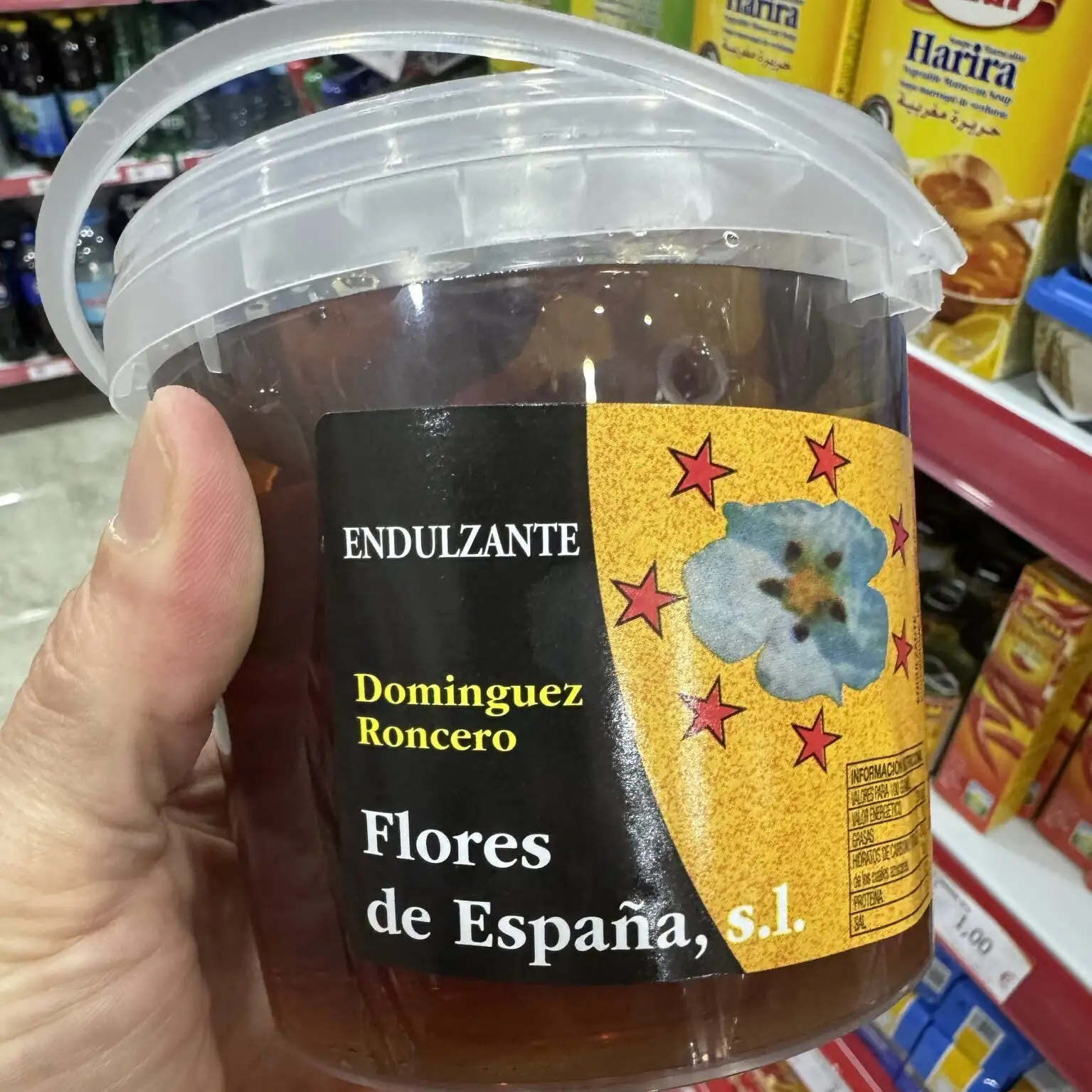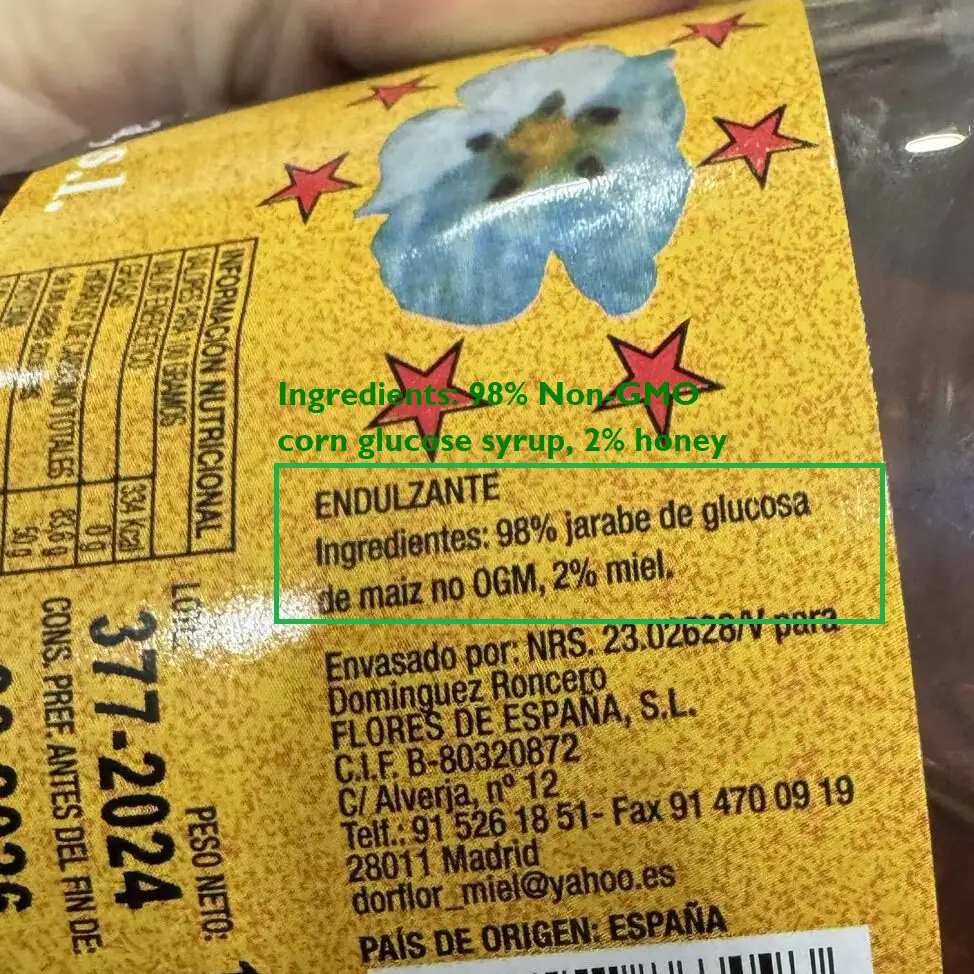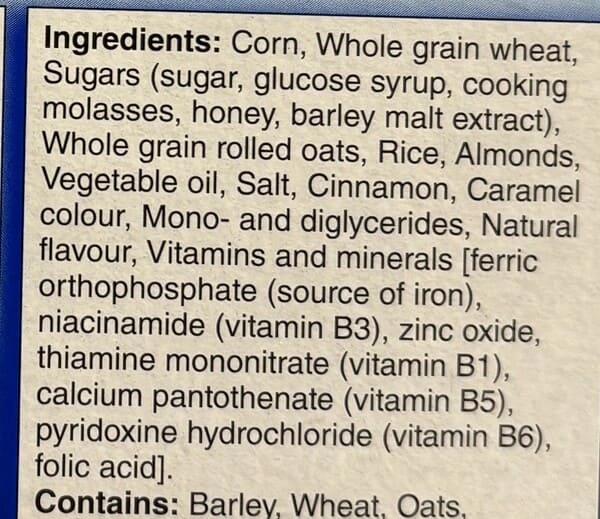
Honest Fake Honey
Wendell Honey beekeeper, Brent Ross, recently reminded me that the ubiquity of falsely labeled, misleadingly marketed and outright fraudulent and adulterated honey on store shelves appears to continue unabatedly. While traveling in Spain on during the beekeeping off season, Brent (who has taken many of our website photos and produced the videos on our youtube channel) sent me photos of jars of what looks like honey labelled “Flowers of Spain”. However, as a beekeeper and a healthy eater, Brent thought to check the label more closely and noticed in the ingredients listed on the jar are: 98% sugar syrup and only 2% honey. While the honey isn’t openly claiming to be pure honey – it’s labelled as “Sweetener” (endulzante) – the “Flowers of Spain” would appear to be intended to give an inattentive consumer the impression that it is honey, or at least came from flowers.


Honey Fraud Isn’t Slowing Down
While the above jar of “sweetener” is a bit of sneaky marketing rather than fraud, honey fraud and adulteration, continue to be large problems that show no signs of decreasing, despite increasing public awareness. Widespread adulteration and over-processing of supermarket honeys first shocked North American consumers in 2011 with Food Safety News’ article “Tests Show Most Store Honey Isn’t Honey”. Honey is the 3rd most adulterated food globally, with only milk and olive oil surpassing honey in levels of adulteration and false labeling. The popular Netflix documentary series “Rotten” focusing on scandals in the food industry devoted its entire first episode to honey fraud, and still only scratched the surface. This article in Wired magazine on widespread adulterated honey and efforts detect it and prevent it from being sold as honey on store shelves was published in 2021.
Much has been reported about how up to 80% of manuka honey on store shelves not being authentic. Here’s just one article. (Aside: manuka honey is thought by many to be healthier than other honeys, but claims that manuka honey has any more health benefits than any other raw honey when eaten lack evidence, and marketed health benefits of eating manuka honey are simply the benefits of eating raw honey.) Another article in the Guardian in 2023 found all UK honey samples tested failed tests for honey authenticity.
At the 2019 and then again at the 2023 World Beekeeping Awards, nearly half of the honey entrants were disqualified for failing authenticity and/or quality parameters. The biannual World Beekeeping Awards is the industry’s most prestigious competitive awards and entrants were informed in advance that their honey would be tested. (We weren’t surprised that Wendell Estate Honey easily passed all of the quality and authenticity tests, but we were honored that our honey won medals in both years that we competed.)
2025.02.17 update: here’s yet another report on adulterated honey. This one from Turkey, a major player on the global honey market. If you think your “Product of Canada” or “USDA organic” honey has nothing to do with countries like Turkey, you may be mistaken. Most organic honey sold in North America is imported, especially if it’s labelled “USDA organic”. Processed honey often includes honey imported cheaply from various countries, especially in the lower price ranges.
2025.02.28 update: And yet another undercover amateur documentary about the scale of honey fraud and its effects on European beekeepers. The effects on the North American beekeepers are pretty similar: being unable to compete on the world market with fake, manufactured and blended “honey”.
Sugary Foods Market Themselves with “Honey” in the Name
As a natural, healthy sweet source of energy that’s high in demand and costly to produce, honey attracts more than its fair share of false marketing. If you’re buying anything appearing to be honey, or marketing itself as sweetened with honey, it’s always wise to check the ingredients label. For foods that market themselves with “honey” in their name, implying that they are sweetened with natural honey – from breakfast cereals, to sauces, to energy snacks – reading the ingredients is useful. When I’ve checked the ingredients on these honey-branded foods, the food often contains much more refined sugars and only minuscule amounts of honey – perhaps just enough to permit them to legally use honey in the name – or even no honey at all. Because honey is much healthier than refined sugars it’s understandable that food companies and marketers would like to associate their product with honey. However, actually sweetening the food with much greater amounts of unhealthy added refined sugar than honey to keep costs shows a lack of integrity.

Labelling Laws Biased Against Honey: Influence of Big Sugar Lobbying?
Canadian labeling laws seem biased against honey, especially in how honey is listed in the ingredients section of food labels. Firstly, when it’s used as an ingredient, honey is now required to be listed in brackets with “Sugars”. There’s ample evidence honey is vastly better for you than refined sugars, in ways that many wouldn’t initially suspect, like promoting weight loss and decreasing the risk of developing diabetes. From a health perspective it seems inappropriate to consider honey in the same category as refined sugars in food labeling.
Secondly, by listing honey parenthetically with sugars, it can appear as though there is more honey than is actually present. As a parent I’d much rather my son eats honey than refined sugars so I’ve been paying attention to the ingredients of foods I buy. Prior to the current labeling laws, honey was listed separately from sugars. For example on some honey-branded breakfast cereals, sugar used to appear second or third on the ingredients list while honey was way down the list, just before or after salt. Under the current regulations, that same tiny amount of honey on the same cereal appears in parenthesis much higher on the ingredients list than other ingredients that compose more of the product, giving the impression that there’s more honey in the food than there actually is in many cases.
Why It Matters
Adulterating honey with refined sugars and “honeywashing” – branding foods with honey while sweetening them with added refined sugars are two facets of the same problem. As refined sugars are both a common food ingredient, and not immediately toxic, it’s easy to downplay these dishonest practices as largely harmless. I think this is a mistake. Each of these dishonest practices cause the same 3 problems (click or tap to expand):
Honey is more valuable and more expensive than refined sugars. If you’re paying for honey, or if you’re paying a premium for a food that intentionally appears to be sweetened with honey, you’re being cheated when you get cheap refined sugar instead. If you pay for a diamond and get a cubic zirconium, that would be a big deal. False or misleading food labeling cheats the consumer economically.
By now there are reams of solid scientific studies that show honey is better for your health than processed sugars. When you think you’re eating pure healthy honey, but are actually being duped into eating refined sugars, instead of reaping natural honey’s health benefits, you’re increasing your risk of heart attacks, diabetes, obesity, and all the other conditions associated with excess dietary refined sugars. Natural raw honey has almost all the opposing health benefits to processed sugars health harms.
To return to the cubic zirconium analogy, in a way paying for honey and getting sugar is even worse. Being cheated with cubic zirconium means you get a lesser value item than the diamond you paid for. From a health perspective, unwittingly eating sugar instead of the honey you paid for is replacing something of value with something detrimental (negative value).
My opinion is that the government (neither in Canada nor the USA) doesn’t take food labeling with respect to honey nor honey adulteration as seriously as it should. This may be due to a lack of direct toxicity due to passing off refined sugars as honey. A more examined approach would be to acknowledge the adverse health effects of sugars being unintentionally consumed due to false labeling or marketing of sugars as honey. If this were studied at a population level where the effects could be more easily quantified, I believe the government would be more likely to crack down on this fraudulent labeling due to population-level morbidity resulting from it and the associated costs to society.
I’m using “Save the bees†somewhat ironically as so many products market themselves as “bee friendly†or “saving the bees†that the term, “beewashing†has been coined for this hollow marketing. However, artificially depressed honey commodity prices due to honey adulteration threaten the livelihoods of many North American beekeepers.
When a brand puts an adulterated honey on supermarket shelves at a low price it drives down the price of retail honey overall, putting downward pressure on the commodity price that beekeepers receive for their honey. At our own honey farm we’ve had too many years where the price of honey was lower than our cost of production. This is an enormous stress for beekeepers like us on the Canadian prairies whose total revenue comes from honey sales.
Honeybees aren’t native to North America, and certainly in the harsh environment of the Canadian prairies, honeybees would not survive without beekeepers to manage their health and keep them alive through the long winters. It’s common knowledge that many foods rely on honeybees for pollination, and without honeybees, food security would be seriously challenged. What many may not appreciate is that in much of North America, without beekeepers there would be no honeybees. Fraudulent honey, via its artificial depression of honey prices, threatens the survival of many beekeeping operations and may ultimately mean that large parts of North America end up without honeybees for pollination of food crops.
Share this story
